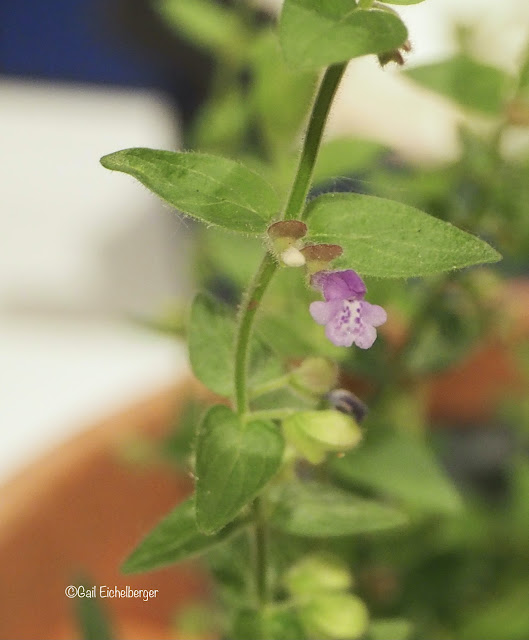Dear readers, There are far too many lovely native wildflowers that are underappreciated or overlooked and Scutellaria parvula is one of them. Even its species name "parvula" means very small and insignificant! It may be small but, it's not insignificant. It's a lovely flower and I hope you are as excited about meeting it as I am to introduce you to our Wildflower Wednesday star.
The flowers of this diminutive beauty are best seen and appreciated close up and that means you gotta get down on your knees to see it's pretty flower face. Trust me when I say, it was so worth the dirty pants to get a close look at this sweet flower. While there I could clearly see the square stems and opposite leaves that are hallmarks of a mint family member.
 |
| Photo Source |
It stands less than a foot high and its tiny flowers are about 1/3 inch long and are located in the leaf axils in the upper third of the plant. The blue/violet tubular corolla flower has fuse petals that form upper and lower lips. The lower lip with its white patch and blue dots is a perfect landing pad for bees.
Those dots on the lower lip are not just for looks they're actually nectar guides. Nectar guides or floral guides as some scientists prefer to call them, are markings or patterns seen in flowers that guide pollinators to their rewards. These markings may appear as lines, spots, or "blotches". Flowers use all kinds of signals/visual displays to attract bees, butterflies and other insects to the nectar source, after all they want pollination to occur! That's how mutualism works: both species benefit, bees collect nectar and pollen from flowers, providing themselves with food and resources, while simultaneously helping the flowers reproduce by transferring pollen from one flower to another.
Nature is truly marvelous.
 |
| interesting seedpods |
Small skullcap is a denizen of limestone outcrops, cedar glades, shallow soil prairies, clearings, savannas, glades, ledges and bluffs, in open forests, in pastures, as well as along railroads and roads in eastern and central north America.
I've seen it growing in a somewhat protected area in my own neighborhood and suspect that once upon a time it could be found in bee friendly lawns all over here. There are areas of limestone outcropping and with its calcareous soil which makes a great place for small skullcap to be found.
 |
| Photo taken in protected area in my neighborhood |
 |
| Source |
I suggest that gardeners plant Scutellaria parvula in the front of their garden bed. It may spread by rhizomes to form a small colony and/or it may seed among your other wildflowers, but it's by no means aggressive, even if it is a member of the mint family.
Missouri Wildflower Nursery has a cool four star rating system for native plants they sell and they've given small skullcap a 3 star rating, which means it has lovely flowers, but they don't think the foliage is beautiful all season. Personally, I like when plants go to seed and I think skullcaps seeds look pretty cool. Btw, they sell Scutellaria parvula if you're interested. Local gardeners, we can find it at Growild.
The Particulars
Botanical name: Scutellaria parvula
Family: Lamiaceae (mint family)
Common names: small skullcap, little skullcap and dwarf skullcap
Species: There are three commonly accepted varieties of Scutellaria parvula which are distinguished by the type and location of hairs on the plant. Two are in Davidson county, TN where I live: Scutellaria parvula Michx. var. australis and Scutellaria parvula Michx. var. australis
Range: Native to eastern US
Zone: 3 to 8
Leaf arrangement: Opposite with square stems
Habit - Perennial forb with fibrous roots and slender Moniliform rhizomes
Bloom time: spring into summer
Flower color: Purple/Blue
Light: Full sun to medium shade
Moisture: Dry, average
Size: 12 inches maximum height
Wildlife value: The flowers are cross-pollinated by various bees, including Mason bees (Osmia spp., Hoplitis pilosifrons), Little Carpenter bees (Ceratina spp.), and Halictid bees (Halictus spp., Lasioglossum spp.). Bees usually suck nectar from the flowers, although some of them also collect pollen. Less common floral visitors include skippers and Syrphid flies, which are less effective at cross-pollination. Insects that are known to feed on the foliage of Small Skullcap include the caterpillars of Prochoreutis inflatella (Skullcap Skeletonizer Moth), the leaf beetles Phyllobrotica lengi and Phyllobrotica limbata, and Asphaera lustrans (Shiny Flea Beetle). Source Illinois Wildflower
Reproduction: If you transplant small skullcap you'll notice that it has formed a string of beads underground; these are the moniliform rhizomes that it produces as a means of reproduction. Stems arise from the "beads".
Comments: Not a preferred food of mammals.
Happy Gardening and while you're walking around do get down on your hands and knees to get a good look at all the sweet low growing small beauties.
xoxogail
Welcome to Clay and Limestone and Wildflower Wednesday. This day is about sharing wildflowers and other native plants no matter where one gardens~the UK, tropical Florida, Europe, Australia, Africa, South America, India or the coldest reaches of Canada. It doesn't matter if we sometimes share the same plants, how they grow and thrive in your garden is what matters most. Sharing native wildflowers on social media is one of the best ways to educate others of their value to wildlife and the ecosystem.
Gail Eichelberger
is a gardener, Tennessee Naturalist and nature writer in Middle
Tennessee. She loves wildflowers and native plants and thoroughly
enjoys writing about the ones she grows at Clay and Limestone. She reminds all that the words and images are the property of the author and cannot be used without written permission.







It's a beauty, for sure!
ReplyDelete